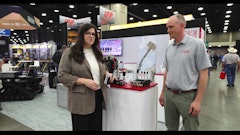For researchers and product developers, creating biobased engine oil has been akin to the search for the Holy Grail. For the past 20 years a number of entities have been experimenting with biobased engine oil. Large groups abandoned the search after numerous trials and being faced with ever-changing specifications related to emissions control, while a small group drove a truck using biobased engine oil, licking the dipstick at various stops to make a point for the product’s “environmental friendliness.”
In Europe, others experimented with the Continuous Oil Recycling System (CORS) concept in diesel automobiles.
While complex esters derived from vegetable oils can be stable enough to handle the engine environment, most current vegetable-oil-based technologies have lacked the necessary stability and cold temperature flowability to perform in the engines in the way petroleum engine oils do.
In 2006, after 15 years of research on industrial lubricants and greases, the University of Northern Iowa expanded the scope of the research at its National Ag-Based Lubricants Center (UNI-NABL), Waverly, IA, to include automotive oils and biofuels. The Center’s researchers began to explore the concept of CORS, technology they had briefly worked with 10 years earlier with an agricultural machinery OEM.
CORS was derived from an aftermarket product that was installed on a diesel engine to continuously steal a small amount of engine oil and feed it to the fuel line. A separate reservoir was used to keep the the crankcase full of fresh oil. After a few fuel-ups, the operator would replenish the oil in the add-on tank.
The main problem with this approach was that the burning of used oil resulted in a negative impact on the already difficult-to-achieve emission standards.
Vegetable-based engine oil
UNI-NABL researchers, along with industrial collaborators, modified the CORS concept to use vegetable-oil based engine oils and created a sophisticated black box called the CORS Convertor. The CORS Convertor communicates with the main processor of the engine, and also has its own sensors and transducers to monitor the condition of the oil and fuel. It is an add-on unit that conceptually resides between the crankcase and the fuel injectors and ensures that oil recycling is performed in a way that is beneficial to the engine.
The CORS Convertor uses sensors plugged into the crankcase to monitor the physiochemical conditions of the engine oil, which is a mixture of modified vegetable oils and a minimal amount of performance-enhancing additives. The CORS Convertor continuously draws oil samples from the crankcase. In addition to evaluating the oil, it conditions it as needed, to be used as fuel.
In effect, the CORS Convertor is like a human kidney that ensures what is fed into the fuel system is cleansed of harmful constituents and is only sent to the fuel system when the engine conditions indicate the best time to use this oil as fuel. For example, a cold engine would not receive vegetable-based oil, and the amount of oil that is fed into the fuel system is varied, based on the ability of the engine’s combustion process to provide the cleanest combustion possible.
Where the original idea of feeding used engine oil into the fuel had a negative impact on emissions, combining CORS with the convertor and vegetable oil can improve exhaust emissions.
Target diesel engines for CORS
The initial target market for CORS is stationary diesel engines, where the addition of an oil tank does not present the logistical problems found with limited space on mobile equipment. To test the concept, UNI-NABL prepared three John Deere diesel engines and instrumented them using an eddy current dynamometer to test the engine under various load conditions.
For engine testing, the maximum load and horsepower setting was selected in order to accelerate the degradation of the oil. When the engine starts, regular diesel fuel is used without mixing. In the meantime, the CORS Convertor draws small quantities of oil from the engine via a positive displacement pump. The physiochemical properties of this oil are monitored by an array of sensors in the crankcase oil.
The CORS Convertor receives the oil and, depending on its condition, sends it through a number of steps based on a proprietary design that may include physical and chemical filtration, addition of chemical catalysts, heating or cooling, etc. Some of the oil will remain in the CORS Convertor in a small reservoir ready to be sent to the fuel system while the remainder will return to the engine crankcase.
The CORS Convertor has three oil lines attached to it; one for bringing in the engine oil for analysis and conditioning, one from the fresh oil reservoir for preparation for injection into the crankcase to replenish the used oil, and one to the crankcase to inject either fresh oil, excess re-conditioned oil, or a mixture of fresh and reconditioned oil into the inlet of the fuel pump.
When the data from the engine control unit (ECU) and the CORS sensors indicate that conditions are right to feed the oil into the fuel, a small quantity, currently not exceeding 2% of the weight of the fuel being consumed, is sent into the inlet side of the fuel injector pump. This creates a biodiesel fuel. Because vegetable oils have been shown to improve the lubricity of ultra-low sulfur fuel, the result is a tribologically more effective fuel. The conditioned oil is void of most of the impurities often found in the used engine oils. Also, the oil is conditioned to proper temperature and at its 2% level, is highly diluted in the fuel. This results in the minimal impact on the power output of the engine due to the naturally lower BTU/volume content of vegetable oils compared to No. 2 diesel fuel.
The system requires installing the sensor assembly into the crankcase and the CORS Convertor to the engine. The CORS Convertor is powered by the engine’s electric system and has its own positive displacement pumps for drawing the used oil from the crankcase and injecting the conditioned oil or the fresh oil into the crankcase. The fresh vegetable engine oil reservoir can be placed anywhere close to the engine. For stationary diesel engines, the oil will sit in the proximity of the fuel tank with plumbing to the CORS Convertor.
Test results
A review of several diesel engines used for farm machinery allowed the researchers to determine the time residency of the oil in the crankcase at different consumption rates.
In order to test the concept, UNI-NABL researchers prepared a pure vegetable base oil with a viscosity of 107 centistokes at 40C as a replacement for 15W 40 diesel engine oil that has a viscosity of 120 centistokes at 40C. The reason for the lower viscosity is because the vegetable base oil has a much higher viscosity index (VI) (about 220; as compared to equivalent petroleum oil with a VI of about 100). This allows the use of thinner oil and lower starting torque requirement, while maintaining the viscosity of the oil at operating temperatures.
The viscosity of the oil was checked every hour, knowing that an increase in viscosity can be a sign of oxidation. After some initial shearing of the oil, the viscosity began to increase after about 10 hours of operation. During this test, CORS was turned off and no oil was being removed for fuel.
The untreated vegetable oil showed stable viscosity for about 10 hours at full load before the viscosity began to increase rapidly and the test was terminated after 14 hours. This viscosity increase was not unexpected as similar viscosity changes had been observed in high pressure, high temperature hydraulic pump tests. Since the engine was running at full load, it is anticipated that a lower level of engine load could increase this performance beyond 10 hours.
Next, a mixture of 75/25 vegetable oils/petroleum was tested with the engine at full load, and the viscosity of the oil remained flat for the entire 100 hours with CORS on. All other variables in the engine indicated that the mixture could be run in the engine indefinitely, as long as an oil volume equal to 2% of the fuel consumption is removed and replaced with fresh oil. Since similar tests have been performed on the fuel using 2% purified vegetable oil in the fuel system without any impact on the engine performance, the researchers were convinced that CORS is viable and will run with clean combustion indefinitely.
The development activities are on-going for optimizing the size and components of the CORS Convertor, improving the accuracy of the sensors assembly, and optimizing the algorithm used on the CORS processor. The engine oil is undergoing further improvements to replace the 25% petroleum portion of the blend with additives in the 75% vegetable oil portion. While the engine tests are continuing in the laboratory, field sites are being identified for long-term tests.
When the oil is consumed at the rate of 2% of the fuel consumption, its residency in the engine is limited, so there is reasonably little need for performance enhancing additives. With the estimated cost of the CORS-based engine oil ranging from $4 to $8/gallon and tracking soybean oil prices at $3 to $7/gallon, as long as diesel fuel prices are over $4/gallon, the oil cost would be zero. This is because the oil would be used as lubricants first and then would be burned with almost par value for the fuel. The inconvenience of having to resupply the fresh oil tank would be compensated with the elimination for the need to change the engine oil.
CORS is still in developmental stage, but it promises to deliver the first engine lubricant using vegetable oils. By adapting new hardware to overcome the shortcomings of vegetable oils, the Holy Grail of biobased lubricants — vegetable oil-based engine oil — may be at hand.
Lou Honary is a University of Northern Iowa professor and the director of National Ag-Based Lubricants Center in Waverly, IA.
![Hcm Ax Landcros Press Release[32] jpg](https://img.oemoffhighway.com/mindful/acbm/workspaces/default/uploads/2025/11/hcmaxlandcros-press-release32jpg.mAEgsolr89.jpg?auto=format%2Ccompress&fit=crop&h=100&q=70&w=100)



![Hcm Ax Landcros Press Release[32] jpg](https://img.oemoffhighway.com/mindful/acbm/workspaces/default/uploads/2025/11/hcmaxlandcros-press-release32jpg.mAEgsolr89.jpg?ar=16%3A9&auto=format%2Ccompress&fit=crop&h=135&q=70&w=240)










